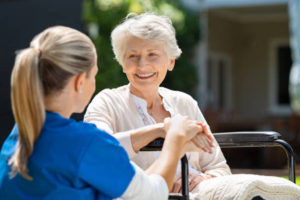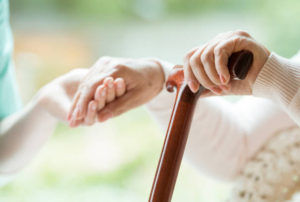How to Prepare for At-Home Care for A Loved One
Reasonable thoughts from a Geriatric Nurse Care Manager & Daughter
By: Hildy Sheinbaum, RN Director of Senior Placement Services, Sterling Care Senior Living Choices LLC
During these recent months, I have received numerous calls from individuals who are at a loss about how to proceed with getting care for their loved one. The emotionally charged outcome always comes down to deciding between two courses of action:
1. Move a parent into an assisted living community OR
2. Have a parent remain in the home with private caregivers.
While I emphasize the words “emotionally charged” in my statement above, never has this been more true than during these COVID times. The angst that individuals express is palpable when faced with choosing between these options.
Before the COVID pandemic, the decision to transition to an assisted living community was far simpler –without the worry that moving a parent to a community setting would expose them more readily to the virus. Likewise, during pre-COVID times, the decision to have a loved one remain in a home setting with care around the clock was also far simpler, without the worry that having aides/caregivers coming in and out would expose them to COVID. The painstaking decision-making process often comes down to simply, “what can I just wrap my head around.” During this time of vaccine rollout and uncertainty, many are choosing to bring care into the home – and trying to do so in the safest way possible. In this blog, I provide guidelines for transitioning to having professionals care for your loved one in the home; considerations will be provided for live-in as well as shift care.
The decision to hire help in the home is often a complex one- and was so even before the coronavirus pandemic. While the added care provides security and peace of mind, it can also require some adjustment for the person being cared for, as well as the family. Some individuals prefer to hire private help in the home often based on friend or family referrals. However, it has always been my recommendation to seek caregivers through a reputable agency, and further, one where there is some professional oversight. It is so important to have an experienced clinician write a care plan for caregivers to follow so that all the client’s needs are addressed consistently, both clinically and psycho-socially. Well-staffed agencies can also step in and find replacements if a caregiver needs time off (emergently or planned).
From a financial point of view, agencies payroll the caregiver, and provide worker’s compensation; this ensures that no labor laws are violated and provides security that a caregiver can receive compensation if an injury occurs in the home, with minimal risk to you for legal action. Sterling Care in Westchester and Fairfield is a great example of a full-service home care agency that provides personalized services in a careful, caring, and comprehensive manner. There is a multidisciplinary team of professionals who contribute to the overall wellbeing of each client.
Regardless of how you select a caregiver, getting used to an unfamiliar person in the home is a process; expectations and guidelines must be set at the beginning to provide the best possible opportunity for success. Below are some suggestions to help make the transition as smooth as possible, especially during these pandemic times.

Pointers For Transition To In-Home Care
1. COVID Screening
Request that the caregiver is screened daily for signs and symptoms of COVID prior to arriving at your loved one’s home. Additionally, request that the caregiver maintain all COVID precautions (both inside and outside of the home) while working for your loved one. For your love one’s safety and out of respect for the caregiver’s wellbeing, it is also important to have family, friends and any workers entering into the home screened for signs and symptoms of COVID before entering. If anyone in the household exhibits COVID signs/symptoms, the agency and caregiver should be notified at once.
2. COVID Testing
Caregivers are no more or less likely to bring COVID into a home than friends or family members. It is not unreasonable to ask the caregiver to be tested 24-48 hours prior to initial arrival. Families who want COVID testing of caregivers may request this, but should also understand that there may be an additional cost, and that testing may delay the start of care. Additionally, testing does not ensure that a caregiver does not have COVID, even with a negative COVID rapid test. Testing only provides information about the status of a viral load at the time of the test itself i.e., a caregiver and anyone else who sees a loved one can develop COVID immediately after having been tested.
3. COVID Vaccine
The best way to protect your loved one from contracting COVID is to have your loved one vaccinated. It is no secret that the vaccine roll-out has been slow. While some caregivers have been vaccinated, others are hesitant to do so. It is also important to realize that thus far, there is no evidence that being vaccinated prevents a person from spreading COVID, so even a vaccinated caregiver or client must abide by all COVID safety precautions. The same holds true for all family members and friends who interact with your loved one.
 4. Introduction to the person being cared for and family
4. Introduction to the person being cared for and family
Inform the caregiver how you would like to be addressed. Some people prefer to be called by first name, while others prefer a more formal surname. Either is acceptable- it is simply a matter of personal preference.
5. Valuables in the Home
Make sure that background and security checks have been done on the caregiver. I do strongly suggest that jewelry, large sums of cash, and small items of value be removed from the house as an added measure of protection.
6. Emergency Contact Information
It is recommended that a list of important phone numbers be placed in an easily accessible area in the home. The list should include all home, work, and cell phone numbers of family members, physicians, and police. A list of client allergies and medications should also be readily available and introduced to the caregiver. If there is a Do Not Resuscitate Order (DNR) in place, make sure that the caregiver is aware. Different states require various forms of documentation or special identification bracelets in order to validate a Do Not Resuscitate Order, and it is important that you familiarize yourself and the caregiver with these requirements.
7. Caregiver food
Live-out caregivers are responsible for bringing their own food. The decision to buy additional food is yours- however, you are NOT obliged to do so. Live-in caregivers are usually provided food for meals that is purchased as part of the regular grocery run. It is a kind gesture to ask about their preferences.
8. Client food
It is customary for the caregiver to prepare meals for the client. It is suggested that the family discuss their loved one’s preferences at the onset. Shopping lists can be prepared jointly at the beginning, and once the caregiver becomes familiar with the client’s taste, he/she can prepare lists independently. A caregiver can do grocery shopping if the family so desires. Arrangements for shopping will need to be made if the client cannot be left alone and is not mobile enough to accompany the caregiver for outdoor errands (see #13 below).
9. Household Expenses
If it is necessary and/or desirable for the caregiver to shop for the client, I recommend that a pre-paid VISA debit card be used for any household expenses such as groceries, supplies, clothing, etc. A set dollar amount should be placed on the card and replenished monthly or as determined. Grocery gift cards to the preferred supermarket is also a good option. The caregiver should be given a large envelope for all receipts and should be instructed to give this to a designated family member at the beginning of each month for reconciliation.
 10. Work Hours and Vacation
10. Work Hours and Vacation
Typically, caregiver scheduling is done through an agency (if being used). Requests for vacation time (1 or more weeks) should be made at least 2 weeks in advance and any change in schedule should be discussed with the family as soon as possible. Discussion about scheduling should take place at the onset. Hourly rate of pay should also be determined at the onset, keeping in mind that the U.S. Department of Labor mandates that overtime (1 1/2 times the base) be paid for over 40 hours of work/week.
A caregiver should be paid on a weekly or bi-weekly basis in accordance with the pre-determined pay scale and the U.S. Department of Labor standards.
When there are 2- 12/hour shifts in place, it is expected that each caregiver will remain awake at all times. This is especially true during the night hours. Keep in mind the purpose for hiring caregivers in shifts (rather than hiring live-in help) is that the client has interrupted sleep and needs assistance during the night hours. The caregiver is being paid to work during that time—and therefore cooking, laundry and other pertinent tasks may be assigned (if the client does sleep during any hours throughout the night).
For live-in help, the caregiver is expected to have uninterrupted down time/sleep for 8 hours/day. If this becomes difficult, other arrangements will need to be made (likely a shift schedule will be necessary). It is suggested that time off (1-2days) be requested 2 weeks in advance whenever possible so that ample coverage may be arranged.
11. Phone Usage
The caregiver can use the client’s phone for all matters pertaining to the client’s care and well-being. It is expected that the caregiver will bring his/her own personal telephone. Calls on personal phones during work hours should be reserved for emergencies; calls may be made on a break-time that is mutually agreed upon with the client/family. It is unacceptable for the caregiver to have earphones or headsets on their person throughout the day. I recommend discussing this at the very beginning of working together.
12. Attire
Caregivers are expected to dress in a clean and professional manner. Soiled clothing, shorts, cut-offs or low-cut clothing is not acceptable. Strong perfume or heavy cologne should be avoided. Again, it is recommended that this be discussed at the onset.
13. General Caregiver Responsibilities
 The caregiver’s primary responsibility is to maintain a healthy and safe environment for the client. Depending on State regulations, he/she is to assist with activities of daily living including, but not limited to bathing, grooming, dressing, toileting, skin care, ambulation, food and fluid preparation and intake, and medication assistance, i.e., adhering to established medication regimen by cuing and reminding.
The caregiver’s primary responsibility is to maintain a healthy and safe environment for the client. Depending on State regulations, he/she is to assist with activities of daily living including, but not limited to bathing, grooming, dressing, toileting, skin care, ambulation, food and fluid preparation and intake, and medication assistance, i.e., adhering to established medication regimen by cuing and reminding.
Additionally, the caregiver is responsible for light housework including laundry for the client, making the client’s bed, cleaning of bathroom, cleaning of spills or soiled areas, kitchen cleanliness after meals and throughout the day when indicated. The family must specify whether the client may be left alone. If it is determined that it is unsafe to do so, at no time may a caregiver leave the home without coverage. The caregiver may be asked to perform other duties in the home within respectful reason.
14. Driving
Typically, agencies allow caregivers to drive a client in the client’s car only. Check with your automobile insurer and the agency, but typically car insurance follows an individual, so a caregiver should be covered under his/her own car insurance policy. If your loved one does not have a car, the caregiver can accompany him/her using Uber, Lyft or a taxi. It is not recommended your loved one drive in a caregiver’s car, as the condition and insurance status of a caregiver’s car is unknown.
15. Travel
It is acceptable for the caregiver to accompany the client for travel/vacation. This should be discussed with the agency and caregiver at the onset if the client/family wishes him/her to do so.
16. For Live-in help, set aside personal space for the caregiver
A private room and bathroom are opportune. Provide closet and drawer space for personal belongings, and a television for use by the caregiver during non-work hours. If the room is at a distance away from the client’s, it is recommended that an audio monitor be provided. In the cases where client safety awareness is questionable, I recommend a monitor with video access so that the caregiver can see what is always taking place.
In summary, treat the caregiver with the same respect and dignity that you would want to be treated. Often families become quite attached to the aides caring for a loved one. It is very important, however, to set boundaries and remember this is a professional relationship, i.e., employee—employer, despite that this is taking place in a home setting. Problems typically arise when that relationship becomes blurred, and people tend to get too comfortable with one another. It is always best to discuss expectations at the very beginning of the working relationship, and to intervene whenever deviations occur. “Nipping in the bud” prevents unwanted habits from building and can avoid an angry and sometimes difficult encounter.
Stay well!
Hildy
View the third article in this series here.